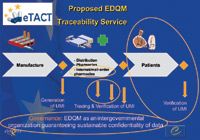Inside EDQM: Mass Serialization to Combat Counterfeit Drugs
Europe establishes new collaborative system to track products.
There is no question about the increasing risk of counterfeiting incidents occurring in the global pharmaceutical supply chain. The manufacture, distribution, and dispensation of medicines are strictly and efficiently controlled in regions such as Europe and the United States, which may explain the low number of counterfeiting incidents that occur in these regions compared with other areas of the world. The high confidence of the public in the pharmaceutical supply chain, however, needs to be maintained and reinforced to keep discouraging patients from purchasing medicines from illegal websites.

Susanne Keitel
Complex supply chains
Awareness campaigns, such as those promoted by the Council of Europe, can assist in this regard. These programs, among other things, direct consumers seeking online pharmaceuticals to the legitimate supply chain. New complex channels of distribution and dispensation, however, are developing. These changes, coupled with economic constraints in public healthcare systems are opening the door to fraud committed by rogue players.
Anticounterfeiting efforts among regulators and business stakeholders have increased in the US and Europe since 2007. During these past few years, several serious incidents of counterfeiting, contamination, and adulteration have occurred, affecting, among others, Plavix, Casodex, and Zyprexa in the UK, and heparin worldwide.
A European mass-serialization strategy
The Council of Europe and its European Directorate for the Quality of Medicines & HealthCare (EDQM) have developed a comprehensive anticounterfeiting strategy that includes several activities, including the training of customs, police and health officers and the adoption of the Medicrime Convention on counterfeiting of medical products and similar crimes involving threats to public health. The Medicrime Convention will be opened for signatures this month (October 2011), and will constitute, for the first time, a binding international legal instrument to combat counterfeiting by criminalizing these activities (1).
As part of this anticounterfeiting strategy, a new EDQM project called eTACT aims to develop a traceability and mass-serialization system that authorities and stakeholders (i.e., manufacturers, suppliers, distributors, healthcare professionals, patients) across the global pharmaceutical supply chain can use.
At its current stage of development, eTACT consists of a live demonstration IT system, developed using nonproprietary standards, with inherent flexibility. The system's repositories will contain data on the pharmaceutical products and items traced (e.g., transaction data, such as the commissioning and registration of new items, packing, shipping, and dispensing).
The main standards followed will be those from GS1, the international nonprofit association dedicated to improving the efficiency and visibility of supply chains. Product identifiers will thus be the GS1 Global Trade Item Numbers (GTINs) and also national product numbers, such as VNRs in the Nordic countries. Master data (i.e., the product name, marketing authorization holder, dose strength) will be registered together with these product number(s).
The item data will be formed by combining the product number(s), a nonsequential and unpredictable serial number, the batch number, and the expiry date of the item. The resulting unique number, a Unique Medicine Identifier (UMI), compliant with GS1 standards, will be placed on the secondary packaging of medicinal products in the form of a 2D Datamatrix barcode. A switch to RFID tags is possible at a later stage when the technology for this data carrier is sufficiently mature.
Transaction data will be registered by system administrators. What data is recorded, who has access to those data and under what circumstances (e.g., alerts, or recalls) will be decided upfront by the stakeholders depending on the market destination of the products, the panEuropean architecture of the system, and the data-sharing option chosen by the manufacturer.
The IT system will be usable along the entire pharmaceutical supply chain to the patient level to prevent entry of the counterfeit products into the marketplace. The system will allow verification of any individual item or package of a medicinal product by querying the directory of the repositories.
System benefits
Allowing patients to verify the authenticity of their medication is a unique feature of EDQM's project that will significantly contribute to strengthening the public's confidence in the legal supply chain. Access for patients will be limited to verification and, given that their credentials will not be checked for privacy reasons, the level of information disclosed to them will be limited compared with that given to registered authorities and business stakeholders. (Figure 1 provides an overview of the eTACT service.)

Figure 1: The new European eTACT service model. EDQM is the European Directorate for the Quality of Medicines. (FIGURE COURTESY OF EDQM)
For products and countries where the system will be used, UMI scanning will be mandatory for manufacturers supplying, and for pharmacies verifying, pharmaceutical products. As a result, a minimum amount of information is always available for verification (i.e., that the item exists, is genuine, and has been dispensed only once by a registered pharmacy).
Other business stakeholders in the supply chain between manufacturers and pharmacies may not be suitably equipped, or may not be willing to use the system systematically for cost reasons or because of high logistical constraints, such as speed of distribution (the efficient pharmaceutical distribution system is an asset to be preserved). For them, querying the UMI or capturing other transaction data (e.g., packing and shipping) will be optional.
This strategy makes the system proposed by the EDQM different from a pedigree or track-and-trace system, as is proposed in California, where any transfer of a pack from one party to another within the supply chain must be recorded, a step that represents a large business constraint.
The eTACT system will rely on a central EDQM repository, supported by decentralized repositories among the manufacturers or with national bodies in an information-sharing model. Existing national systems will remain in place.
The flexibility of this approach is a prerequisite for dealing with the key challenge of interoperability and for preparing for the complex implementation of future European requirements for the traceability of medicinal products, as defined by the recently adopted European Union Falsified Medicines Directive 2011/62 and its future delegated acts (2).
Conclusion
By providing business stakeholders and regulators with a flexible pan-European system, the EDQM eTACT project allows for a harmonized, standardized, and centralized securitization of the legitimate pharmaceutical supply chain, whatever the distribution route. The system extends to the legitimate Internet sales of medicines promoted in some European countries.
Public governance of such a system is vital to ensure effective and proper project development in coordination with regulatory authorities and to prevent the misuse of data (e.g., commercial data or information to patients on products).
Susanne Keitel is director of the European Directorate for the Quality of Medicines and Healthcare (EDQM) of the Council of Europe in Strasbourg, France. EDQM is responsible for the European Pharmacopoeia (Ph.Eur.), Susanne.Keitel@edqm.eu.
References
1. Council of Europe, Medicrime Convention, 2010.
2. EU, Directive 2011/62/EU (European Parliament and Council, Strasbourg, June 2011).

PacBio Chosen as Tech Partner for Global Alzheimer’s Disease Research Project
April 23rd 2025The project, the North African Dementia Registry, will unite multiple entities for the purpose of developing a comprehensive dataset to advance the research community’s understanding of Alzheimer’s disease and other dementias in diverse populations.